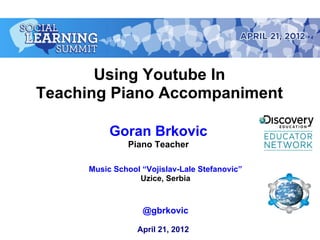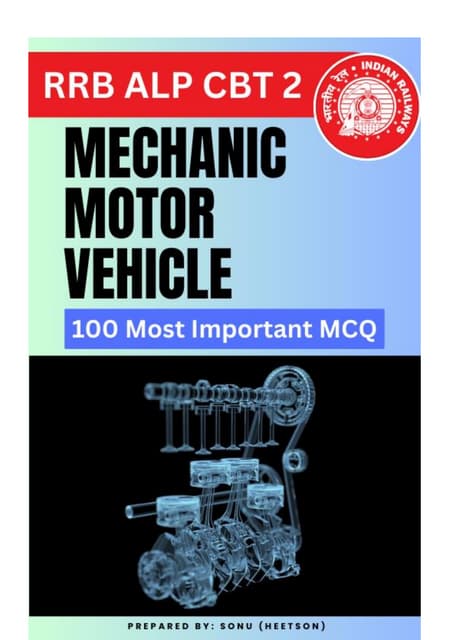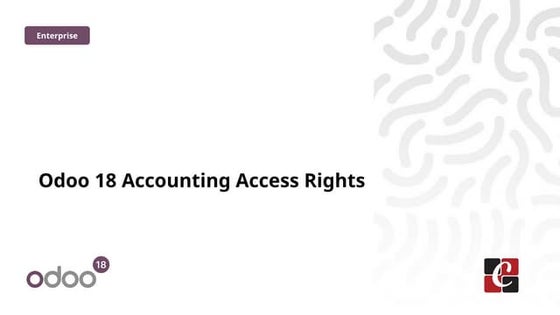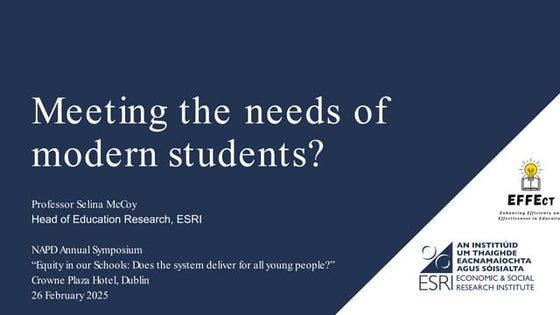Social learning summit 2012 using youtube for teaching piano accompaniment
- 1. Using Youtube In Teaching Piano Accompaniment Goran Brkovic Piano Teacher Music School “Vojislav-Lale Stefanovic” Uzice, Serbia @gbrkovic April 21, 2012
- 2. The session will include the following topics: - Introduction - The main problem in teaching piano accompaniment - The old way we used to teach it and the problems it involved - The new way: how technology can help teachers and students - About using YouTube - Class Plan - Lesson Timing - How to use Youtube in piano accompaniment class and its benefits - Additional info
- 3. Introduction About me: - piano teacher - 21 years, piano accompanist - 10 years About piano accompaniment: - to watch and listen to several parts of the score - to adapt our own playing to the soloist About piano accompaniment lessons - two pupils in a group at one lesson - 35 classes per year, 45 minutes per class, 1 class per week - no final exam, two obligatory public performances - program: pieces for flute, violin or voice and piano - main goal: to educate piano students how to play piano accompaniment well on public performances.
- 4. The main problem in teaching piano accompaniment How to achieve adaptability while teaching it the old way ? Solo piano vs. piano accompaniment - solo: listening skills limited to our own playing -piano accompaniment: listening to both ourselves and others Easier: - not being alone at the podium - no memorization More complex: - more staves, requires greater musical flexibility, listening to ourselves, listening to others, coordination of both = adapting
- 5. The old way we used to teach it and the problems it involved Limited usability: - no preparation for the public performance. The old fashioned class: - one piano student plays imitating the soloist, the other piano students plays along piano accompany part - both piano students playing on the piano, same instrument color - too exact tempo, same moment of sound production - no breathing pauses and agogics â—Ź artificial and unreal â—Ź less adaptation or no adaptation to the real soloist Solution: the new way of teaching.
- 6. The new way: how technology can help teachers and students New way of teaching brings increased class usability: - two students, two different pieces, accompanying YT - 8 - 20 real soloist performances from Youtube - students in real life situation 100% percent of the time during the lesson - never use the same performance on two lessons - different soloists from YT posses various artistic levels of performance. Developing skills: - listening to various and different instrument colors - catching constant small tempo variations, including breaths - adaptability to other performer's musical ideas, dynamics - "hunting", jumping, listening to false intonation, wrong rhythm...
- 7. About using YouTube Using Youtube (www.youtube.com) requirements: - PC, broadband Internet connection and speakers Problems and solutions: - no PC / speakers > use laptop or portable devices with headphones - no Internet connection > download videos and bring to the class Teacher's preparation for the lesson - choosing the pieces, according to student ability, grade - search YT for pieces, select useful performances - collect and save the links, keep tracks of what is already done making notes and reflections about students' achievements - allowing some time for students to read and learn the pieces
- 8. Class plan Lesson planning and preparation: - coordination - check with other teacher (flute, violin, etc.) - variety - mastering pieces of various difficulty and differently structured pieces - finding informations about composer and the piece - links to pdf sheet music, or sending pdf sheet music to students - analyzing the score, defining smaller parts / numbers, sheet printing, writing rehearsal numbers on sheet
- 9. Example of Piano accompaniment class 8 flutists playing Saint-Saens Romance op.37, D flat major - About composer: http://en.wikipedia.org/wiki/Camille_Saint-Sa%C3%ABns - About Romance: http://bit.ly/IfOsjJ - Sheet Music: http://bit.ly/I0zscq YouTube links: http://www.youtube.com/watch?v=P6gioeVi9f4&feature=related http://www.youtube.com/watch?v=Dg3RMuyLFy0 http://www.youtube.com/watch?v=LNusStMhI50 http://www.youtube.com/watch?v=ci-jBYNlpP4 http://www.youtube.com/watch?v=xEMRxrV4Ff8 http://www.youtube.com/watch?v=AKCcZGbe7Qs&feature=related http://www.youtube.com/watch?v=Ej3mr4LHjeA&feature=related http://www.youtube.com/watch?v=su2UdsMK1lE&feature=related
- 11. About the Piece
- 12. Sheet Music from IMSLP
- 14. 8 flutists playing Rachmaninoff Vocalise op.34 No.14, G minor About Rachmaninoff: http://en.wikipedia.org/wiki/Sergei_Rachmaninoff About Vocalise: http://en.wikipedia.org/wiki/Vocalise_(Rachmaninoff) Sheet Music: http://www.scorage.ru/view.aspx?id=844C7303DC16CB116838E196B7AF17F2 Youtube links http://www.youtube.com/watch?v=SxXS-8NfjNU&feature=related http://www.youtube.com/watch?v=j_Ha_uRF-84 http://www.youtube.com/watch?v=eVurqiFHBxQ http://www.youtube.com/watch?v=uvpBUitKbsQ http://www.youtube.com/watch?v=sAvkcUuUpLo http://www.youtube.com/watch?v=fJtbeAC_PQ8 http://www.youtube.com/watch?v=4fVAthVOx2M http://www.youtube.com/watch?v=N2xZICRj9qY&feature=related
- 15. Lesson Timing Lesson duration: 45 minutes Lesson organization: 3 x 15 minutes 1) warming up, without accompanying the YT recording, every student works on her / his own part, the most demanding spots 2) one student accompanying YT video recording - 15 minutes - integral performance, accompanying Saint-Saens Romance, finding what is most important to listen to, focus on middle section, harmonies played in chords, finding the logic of harmonies and agogics - homework: accompanying the YT recording while playing left hand only, simultaneous harmony changes 3) the other student accompanying YT video - 15 minutes - integral performance, accompanying Rachmaninoff Vocalise - without repeated intervals / chords, the basis of the structure, "invisible" repeats, finger Pedal, obtaining clear Pedaling, playing middle section only, in slower tempo, agogics - making synthesis at the end with YT video again - homework: practice hands separate with YT video, with & without repeated chords.
- 16. How to use Youtube in piano accompaniment Class and its benefits Analyzing : tonalities, form, dividing into parts for practicing Learning the solo part - better listening, better troubleshooting Sight reading - always beneficial, less time to learn new pieces Exercises - rearranging the structure, creating orchestral arrangements in Concertos Transposing piano part - gradually increasing the difficulty, transposing in real- time, accompanying recorded solo Benefits of this type of teaching piano accompaniment: - more efficient teaching, more interesting, practicing real life public performance 100% of the class time.
- 17. Additional info - I recommend using Ubuntu Linux (www.ubuntu.com) and Puppy Linux (http://puppylinux.org), free, stable and secure OS - Use Audacity (http://audacity.sourceforge.net) to record your student's progress. You can use podcasts at your lessons, like shown in presentation created by Maja Dakic-Brkovic: (http: //www.slideshare.net/kakoto/maja-teach-meet-podcast-in-piano-lessons). - Rosegarden is score editor used to analyze or explain the most complex part of the score. My presentaion about Rosegarden: (http://www.slideshare.net/gbrkovic/rosegarden-notation).
- 18. Using Youtube In Teaching Piano Accompaniment Goran Brkovic Piano Teacher Music School “Vojislav-Lale Stefanovic” Uzice, Serbia @gbrkovic April 21, 2012

































































